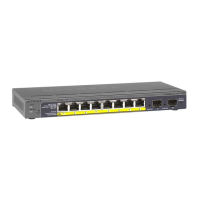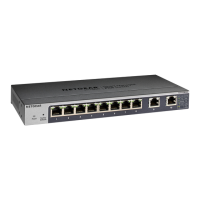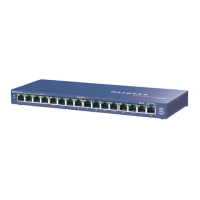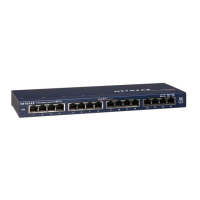8-Port Gigabit (PoE+) Ethernet Smart Managed Pro Switch with (2 SFP or 2 Copper Ports and)
Cloud Management
Configure Switching User Manual143
The following table describes the nonconfigurable data that is displayed.
Table 27. Port Configuration information
Field Description
Port Type For normal ports this field is blank. Otherwise, the options are as follows:
• Mirrored.
The port is a mirrored port on which all the traffic is copied to
the probe port.
• Probe. Use the port to monitor a mirrored port.
• Trunk Member.
The port is a member of a link aggregation trunk. Look
at the LAG pages for more information.
Physical Status The port speed and duplex mode.
Link Status Indicates whether the link is up or down.
Frame Size (1522 to 10000) The maximum Ethernet frame size that each interface can support. The
frame size depends on your selection from the Frame Size menu above the
table and applies to each interface.
MAC Address The physical address of the specified interface.
PortList Bit Offset The bit offset value that corresponds to the port when the MIB object type
PortList is used to manage in SNMP
.
ifIndex The ifIndex of the interface table entry associated with the port.
Configure link aggregation groups
Link aggregation groups (LAGs), which are also known as port channels, allow you to
combine multiple full-duplex Ethernet links into a single logical link. Network devices treat the
aggregation as if it were a single link, which increases fault tolerance and provides load
sharing. You assign the LAG VLAN membership after you create a LAG. By default, the LAG
becomes a member of the default management VLAN (that is, VLAN 1).
A LAG interface can be either static or dynamic, but not both. All members of a LAG must
participate in the same protocols.
A static port channel interface does not require a partner
system to be able to aggregate its member ports.
The switch supports static LAGs. When a port is added to a LAG as a static member, the port
neither transmits nor receives LACPDUs.
The switch supports eight LAGs.
Configure LAG settings
You can group one or more full-duplex Ethernet links to be aggregated together to form a link
aggregation group, which is also known as a port channel. The switch treats the LAG as if it
were a single link.

